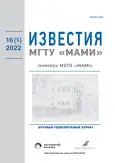Исследование возможности оптимизации насосного агрегата для двух режимов работы, отличных от оптимального
- Авторы: Ломакин В.О.1, Протопопов А.А.1, Михеев К.Г.1,2, Веселов А.А.1
-
Учреждения:
- Московский государственный технический университет им. Н.Э. Баумана
- Научно-производственное объединение гидравлических машин – Гидромаш
- Выпуск: Том 16, № 1 (2022)
- Страницы: 29-37
- Раздел: Гидравлические и пневматические системы
- URL: https://journals.rcsi.science/2074-0530/article/view/109242
- DOI: https://doi.org/10.17816/2074-0530-109242
- ID: 109242
Цитировать
Полный текст
Аннотация
Введение. Исследование факторов, влияющих на виброакустические характеристики насосов, является одним из главных направлений работ в нынешнем насосостроении. Улучшение этих характеристик позволяет не только продлить срок службы насосов за счет снижения уровней вибрации, но и уменьшить уровень шума.
Цель. В рамках данной работы предпринята попытка произвести оптимизацию проточной части многоступенчатого насоса для получения приемлемых виброшумовых характеристик (ВШХ) в двух режимах работы, отличных от оптимального.
Методы. В результате исследования было установлено, что изменение этих параметров в угоду ВШХ отрицательно сказывается на КПД насоса и наоборот. Из-за этого потребуется искать оптимальный баланс между этими параметрами. Оптимизация проводилась с помощью метода исследования пространства параметров с применением ЛП-тау последовательностей. В качестве параметров оптимизации были выбраны следующие элементы: площадь на входе в отвод, угол направляющих лопастей на входе в отвод, ширина рабочего колеса на выходе, угол лопастей рабочего колеса на входе и выходе, угол охвата лопасти в рабочем колесе. В качестве критерия оптимизации было выбрано уменьшение площади под графиком спектра пульсаций давления. Математическая модель была верифицирована по двум произведенным и испытанным ранее вариантам проточных частей. Первый образец имел завышенные показатели спектра ВШХ в области высоких частот, второй же имел завышенные показатели в области низких частот.
Результаты. Составленная математическая модель качественно показала такие же результаты, что позволяет говорить о допустимости ее применения для оптимизации проточных частей насосов.
Заключение. Данная работа будет интересна специалистам в области проектирования лопастных гидромашин.
Полный текст
Открыть статью на сайте журналаОб авторах
Владимир Олегович Ломакин
Московский государственный технический университет им. Н.Э. Баумана
Email: lomakin@bmstu.ru
ORCID iD: 0000-0002-9655-5830
SPIN-код: 3467-7126
д-р техн. наук, заведующий кафедрой Э10 «Гидромеханика, гидромашины и гидропневмоавтоматика»
Россия, 2-я Бауманская ул., д.5, Москва, 105005Александр Андреевич Протопопов
Московский государственный технический университет им. Н.Э. Баумана
Email: proforg6@yandex.ru
ORCID iD: 0000-0002-6069-7730
SPIN-код: 4175-5118
канд. физ.-мат. наук, заместитель заведующего кафедрой Э10 «Гидромеханика, гидромашины и гидропневмоавтоматика»
Россия, 2-я Бауманская ул., д.5, Москва, 105005Константин Геннадьевич Михеев
Московский государственный технический университет им. Н.Э. Баумана; Научно-производственное объединение гидравлических машин – Гидромаш
Email: zamgdpro@gidromash.com.ru
ORCID iD: 0000-0002-3142-6755
SPIN-код: 5320-2940
технический директор
Россия, 2-я Бауманская ул., д.5, Москва, 105005; МоскваАлексей Андреевич Веселов
Московский государственный технический университет им. Н.Э. Баумана
Автор, ответственный за переписку.
Email: veselov.aleksei98@gmail.com
ORCID iD: 0000-0003-3505-5848
SPIN-код: 6561-3300
студент кафедры Э10 «Гидромеханика, гидромашины и гидропневмоавтоматика»
Россия, 2-я Бауманская ул., д.5, Москва, 105005Список литературы
- Tokarev A.P., Yanbarisova A.A., Khatmullina R.S. The Dependence of the Pump Piping Vibration from the Rotor Speed // IOP Conference Series: Earth and Environmental Science. 2021. Vol. 666, N 4. doi: 10.1088/1755-1315/666/4/042065
- Dutta N., Kaliannan P., Subramaniam U. Effect of Motor Vibration Problems on Power Quality of Water Pumping at Residency // IOP Conference Series: Materials Science and Engineering. 2020. Vol. 937, N 1. doi: 10.1088/1757-899x/937/1/012019
- Protopopov A., Makhlaeva A., Kaplenkova P. Predicted resource of the most loaded centrifugal pump bearing // IOP Conference Series: Materials Science and Engineering. 2020. Vol. 779, N 1. doi: 10.1088/1757-899x/779/1/012017
- Lobsinger T., Hieronymus T., Schwarze H., Brenner G. A CFD-Based Comparison of Different Positive Displacement Pumps for Application in Future Automatic Transmission Systems // Energies. 2021. Vol. 14, N 9. doi: 10.3390/en14092501
- Iannetti A., Stickland M.T., Dempster W.M. A CFD and experimental study on cavitation in positive displacement pumps: Benefits and drawbacks of the ‘full’ cavitation model // Engineering Applications of Computational Fluid Mechanics. 2015. Vol. 10, N 1. P. 57–71. doi: 10.1080/19942060.2015.1110535
- Ding H., Visser F.C., Jiang Y., Furmanczyk M. Demonstration and Validation of a 3D CFD Simulation Tool Predicting Pump Performance and Cavitation for Industrial Applications // Journal of Fluids Engineering. 2011. Vol. 133, N 1. doi: 10.1115/1.4003196
- Averyanov A., Protopopov A. Mathematical modeling of a centrifugal pump with a spiral tap of simplified geometry with an open and closed wheel // IOP Conference Series: Materials Science and Engineering. 2020. Vol. 779, N 1. doi: 10.1088/1757-899x/779/1/012048
- Isaev N., Budaev G., Danilov D., Dobrokhodov K. Investigation of the influence of wear in impeller seals on the axial force in double suction pumps // IOP Conference Series: Materials Science and Engineering. 2020. Vol. 779, N 1. doi: 10.1088/1757-899x/779/1/012051
- Ломакин В.О. Разработка комплексного метода расчета проточных частей центробежных насосов с оптимизацией параметров: дис. ... д-ра техн. наук. Москва, 2013. Режим доступа: https://www.dissercat.com/content/razrabotka-kompleksnogo-metoda-rascheta-protochnykh-chastei-tsentrobezhnykh-nasosov-s-optimi Дата обращения: 27.07.2022.
Дополнительные файлы

















